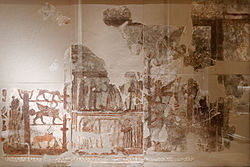Investiture of Zimri-Lim

Overview of the fresco
|
|
| Material | Mural painting on white plaster |
|---|---|
| Size | 4.25 square metres (45.7 sq ft) |
| Height | 1.7 metres (5 ft 7 in) |
| Width | 2.5 metres (8 ft 2 in) |
| Created | c. 18th century BC |
| Period/culture | Amorite |
| Discovered | 1935–1936 |
| Place | Royal palace of Mari, Syria |
| Present location | Musée du Louvre, Paris |
| Identification | AO 19826 |
| Mari |
 Euphrates • Terqa • Tuttul Royal Palace |
| Kings |
|
Yaggid-Lim • Yahdun-Lim Yasmah-Adad Zimri-Lim (Queen Shibtu) |
| Archaeology |
|
Investiture of Zimri-Lim Statue of Ebih-Il Statue of Iddi-Ilum |
The Investiture of Zimri-Lim is a large colorful mural discovered at the Royal Palace of the ancient city-state of Mari in eastern Syria. The fresco, which dates back to the 18th century BC, depicts Zimri-Lim, king of Mari, receiving the symbols of rule (a ring and a staff) from the goddess Ishtar. The painting was discovered in situ on its original wall located opposite the grand doorway to the podium which leads to the throne room of the palace. It was discovered by French archaeologist André Parrot during excavations at Mari in 1935–1936. The painting is now displayed at the Musée du Louvre in Paris, France.
The painting is composed of three vertical panels arranged symmetrically, with the two outer sections framing the central one. The middle panel is divided horizontally into two rectangular registers framed by six parallel lines of different colors. The painting's symmetry facilitates the reconstruction of the damaged part on the left panel.
The painting is said to reflect the actual architecture of the palace in which the mural was located. The lower register of the middle panel reflects the podium room in which the body of a statue of a goddess similar to the goddess Lama depicted in the mural was discovered. The statue had a vase from which actual water flowed. The podium room opens up to the throne room, where the investiture takes place. The palm trees depicted in the side panels represent actual trees that were planted in the palace's courtyard.
The upper register of the middle panel is the center of the mural and depicts the solemn scene of investiture. It is composed of five people standing against a blank background. Ishtar is depicted wearing her divine crown, with weapons sprouting from her shoulders and a sickle-sword in her left hand, and presenting the king with the symbols of authority (a ring and a staff). The king is extending his left hand to the goddess, while his right hand is depicted against his mouth in a symbol of prayer. On either side of the king and Ishtar stands a Lama deity, the minor goddess of intercession in Mesopotamia, wearing a horned headdress. To the right stands Ninshubur, the vassal of Ishtar.
...
Wikipedia
